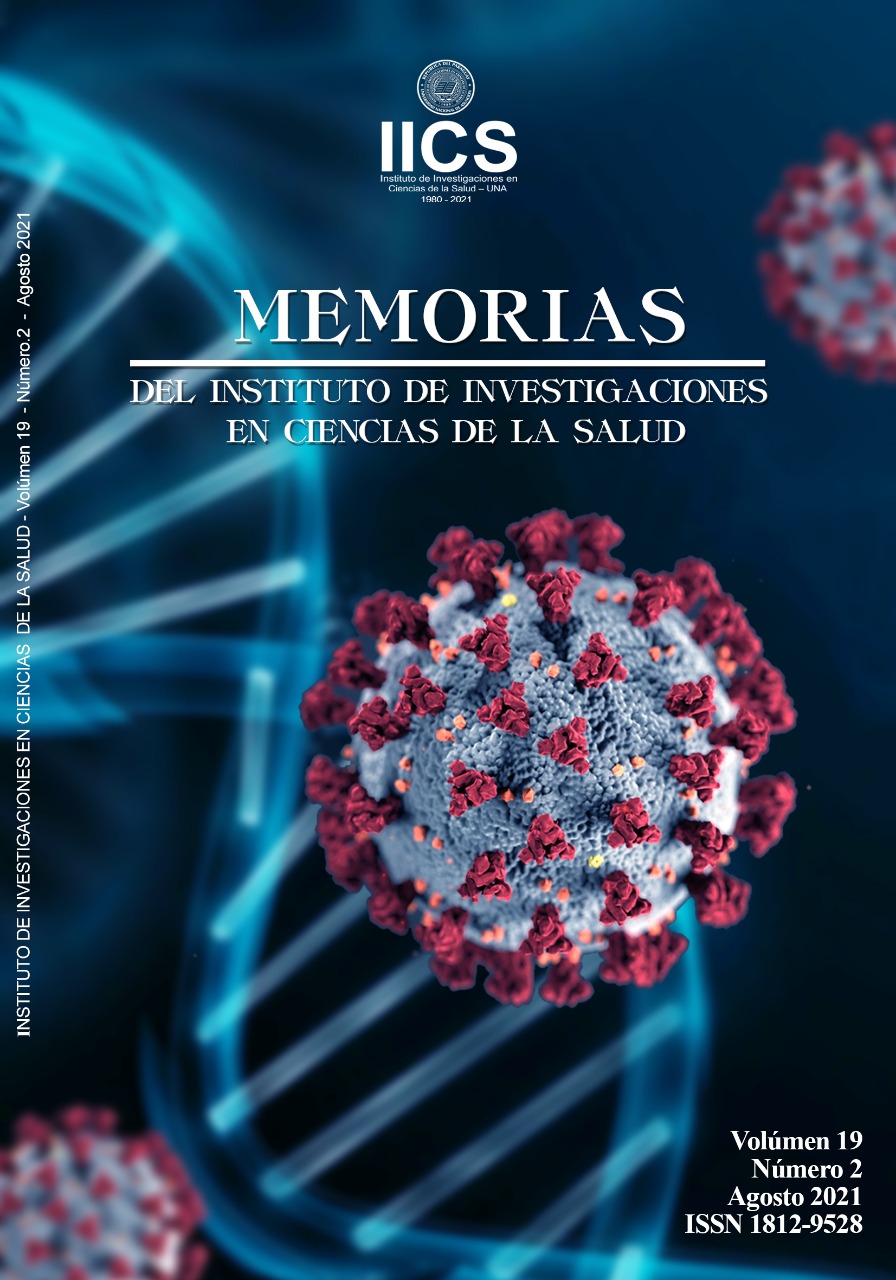Características clínicas, demográficas y acceso a los productos sin gluten de pacientes con enfermedad celíaca registrados en la FUPACEL
DOI:
https://doi.org/10.18004/mem.iics/1812-9528/2021.019.02.78Keywords:
Enfermedad celíaca, presentación clínica, dieta libre de glutenAbstract
La enfermedad celíaca (EC) es una enfermedad inflamatoria autoinmune que afecta la mucosa del intestino delgado que lleva a un estado de mal absorción en pacientes genéticamente susceptibles desencadenada por la ingesta de gluten. Tiene síntomas inespecíficos, complicaciones asociadas y no existe a nivel nacional una ley de apoyo económico para las personas con dificultad para seguir una dieta libre de gluten. El objetivo de este estudio observacional, descriptivo, de corte transversal fue describir las características clínicas, demográficas y acceso a productos sin gluten de 237 pacientes con enfermedad celíaca registrados en la Fundación Paraguaya de Celiacos (FUPACEL) en el 2020 y que aceptaron responder una encuesta en línea publicada en la página oficial de la FUPACEL. El 70,4% de los participantes era del sexo femenino, la edad de diagnóstico fue en el 34,5% entre 20-30 años, 48 % tenía algún familiar con EC, el 69,1% presentó distensión abdominal como sintomatología inicial, 16,8% presentó hipotiroidismo como patología asociada, y 42% fue hospitalizado al menos una vez. El 82,7% de los encuestados respondió que la dieta era suficiente como tratamiento, 48% tenía un trabajo y podía solventar los gastos, sin embargo, el 79,3% opinó tener acceso limitado a los productos sin gluten, el 92% que los alimentos sin gluten eran costosos y que se necesitaba una ley de apoyo económico para solventar los gastos. La mayoría reconoció que la dieta sin gluten como tratamiento era suficiente, sin embargo, por su alto costo se necesita una ley de apoyo económico para las personas con enfermedad celiaca.
Downloads
References
Fasano A, Catassi C. Clinical practice. Celiac disease. N Engl J Med. 2012 Dec 20; 367(25): 2419-26. doi: 10.1056/NEJMcp1113994.
Kagnoff MF. Overview and pathogenesis of celiac disease. Gastroenterology. 2005; 128(4 Suppl 1): S10-8.
Goldberg AD, Allis CD, Bernstein E. Epigenetics: a landscape takes shape. Cell. 2007; 128(4): 635-8.
Husby S, Koletzko S, Korponay-Szabó IR, Mearin ML, Phillips A, Shamir R, et al. European Society for Pediatric Gastroenterology, Hepatology, and Nutrition guidelines for the diagnosis of coeliac disease. J Pediatr Gastroenterol Nutr. enero de 2012; 54(1):136-60. Erratum in: J Pediatr Gastroenterol Nutr. 2012 Apr; 54 (4): 572.
Kang JY, Kang AH, Green A, Gwee KA, Ho KY. Systematic review: worldwide variation in the frequency of coeliac disease and changes over time. Aliment Pharmacol Ther. 2013 Aug; 38(3): 226-45. doi: 10.1111/apt.12373.
Dubé C, Rostom A, Sy R, Cranney A, Saloojee N, Garritty C, et al. The prevalence of celiac disease in average-risk and at-risk Western European populations: a systematic review. Gastroenterology . 2005 Apr; 128 (4 Suppl 1): S57-67. doi: 10.1053/j.gastro.2005.02.014.
Riestra S, Fernández E, Rodrigo L, Garcia S, Ocio G. Prevalence of Coeliac disease in the general population of northern Spain. Strategies of serologic screening. Scand J Gastroenterol. 2000 Apr; 35(4): 398-402. doi: 10.1080/003655200750023967.
Farrell RJ, Kelly CP. Celiac sprue. N Engl J Med. 2002 Jan 17; 346(3):180-8. doi: 10.1056/NEJMra010852.
Hardy MY, Tye-Din JA. Coeliac disease: a unique model for investigating broken tolerance in autoimmunity. Clin Transl Immunology. 2016 Nov 2; 5(11): e112. doi: 10.1038/cti.2016.58.
Shannahan S, Leffler DA. Diagnosis and Updates in Celiac Disease. Gastrointest Endosc Clin N Am. 2017 Jan; 27(1):79-92. doi: 10.1016/j.giec.2016.08.011.
Ontiveros N, Real-Delor RE, Mora-Melgem JA, Beltrán-Cárdenas CE, Figueroa-Salcido OG, Vergara-Jiménez M de J, et al. Prevalence of Wheat/Gluten-Related Disorders and Gluten-Free Diet in Paraguay: An Online Survey-Based Study. Nutrients. 27 de enero de 2021; 13(2):396. Melissa Jeruti Enciso. Se estima que hay más de 60.000 celiacos en Paraguay y la mayoría no lo sabe. 17 de noviembre de 2015; Disponible en: http://economiavirtual.com.py/web/pagina-general.php?codigo=3959
Real Delor RE, Arza G, Chamorro ME, Dalles I, Ibarra Douglas A. La Enfermedad celiaca en el Paraguay. Rev Nac (Itaugua). 2011; 3(2):7-15.
Real Delor RE, Centurión Medina IC. Calidad de vida en adultos del Paraguay con enfermedad celiaca. Duazary: Revista internacional de Ciencias de la Salud 2018; 15(1):61-70.
Kupper C. Dietary guidelines and implementation for celiac disease. Gastroenterology. 2005 Apr; 128 (4 Suppl 1): S121-7. doi: 10.1053/j.gastro.2005.02.024.
Nasr I, Leffler DA, Ciclitira PJ. Management of celiac disease. Gastrointest Endosc Clin N Am. 2012 Oct; 22(4): 695-704. doi: 10.1016/j.giec.2012.07.012.
Hall NJ, Rubin G, Charnock A. Systematic review: adherence to a gluten-free diet in adult patients with coeliac disease. Aliment Pharmacol Ther. 2009 Aug 15; 30(4): 315-30. doi: 10.1111/j.1365-2036.2009.04053.x.
Defensor del Pueblo. Estudio sobre la situación de las personas con Enfermedad celiaca en España [Internet]. Consejería de Sanidad de la Comunidad de Madrid. Vol. 1. Madrid, España: Lettergraf, S.A; 158 Disponible en: https://www.defensordelpueblo.es/wp-content/uploads/2017/04/Celiaquia_2017-1.pdf
Fasano A, Berti I, Gerarduzzi T, Not T, Colletti RB, Drago S, et al. Prevalence of celiac disease in at-risk and not-at-risk groups in the United States: a large multicenter study. Arch Intern Med. 2003 Feb 10; 163(3): 286-92. doi: 10.1001/archinte.163.3.286.
Green PHR, Stavropoulos SN, Panagi SG, Goldstein SL, Mcmahon DJ, Absan H, Neugut AI. Characteristics of adult celiac disease in the USA: results of a national survey. Am J Gastroenterol. 2001 Jan; 96(1): 126-31. doi: 10.1111/j.1572-0241.2001.03462.x.
Costa Gomes R, Cerqueira Maia J, Fernando Arrais R, André Nunes Jatobá C, Auxiliadora Carvalho Rocha M, Edinilma Felinto Brito M, et al. The celiac iceberg: from the clinical spectrum to serology and histopathology in children and adolescents with type 1 diabetes mellitus and Down syndrome. Scand J Gastroenterol . 2016; 51(2):178-85. doi: 10.3109/00365521.2015.1079645.
Laurikka P, Nurminen S, Kivelä L, Kurppa K. Extraintestinal Manifestations of Celiac Disease: Early Detection for Better Long-Term Outcomes. Nutrients . 2018 Aug 3; 10(8): 1015. doi: 10.3390/nu10081015.
Pelegrí Calvo C, Soriano del Castillo JM, Mañes Vinuesa J. Calidad de vida y proceso diagnóstico en celíacos adultos de la Comunidad Valenciana. Nutr Hosp. 2012 Jul-Aug; 27(4): 1293-7. doi: 10.3305/nh.2012.27.4.5871.
Green PH. The many faces of celiac disease: clinical presentation of celiac disease in the adult population. Gastroenterology . 2005 Apr; 128 (4 Suppl 1): S74-8. doi: 10.1053/j.gastro.2005.02.016.
Hansen D, Brock-Jacobsen B, Lund E, Bjørn C, Hansen LP, Nielsen C, et al. Clinical benefit of a gluten-free diet in type 1 diabetic children with screening-detected celiac disease: a population-based screening study with 2 years' follow-up. Diabetes Care. 2006 Nov; 29 (11): 2452-6. doi: 10.2337/dc06-0990.
White LE, Bannerman E, Gillett PM. Coeliac disease and the gluten-free diet: a review of the burdens; factors associated with adherence and impact on health-related quality of life, with specific focus on adolescence. J Hum Nutr Diet. 2016 Oct; 29(5):593-606. doi: 10.1111/jhn.12375.
Estévez V, Ayala J, Vespa C, Araya M. The gluten-free basic food basket: a problem of availability, cost and nutritional composition. Eur J Clin Nutr. 2016 Oct; 70(10): 1215-1217. doi: 10.1038/ejcn.2016.139.















